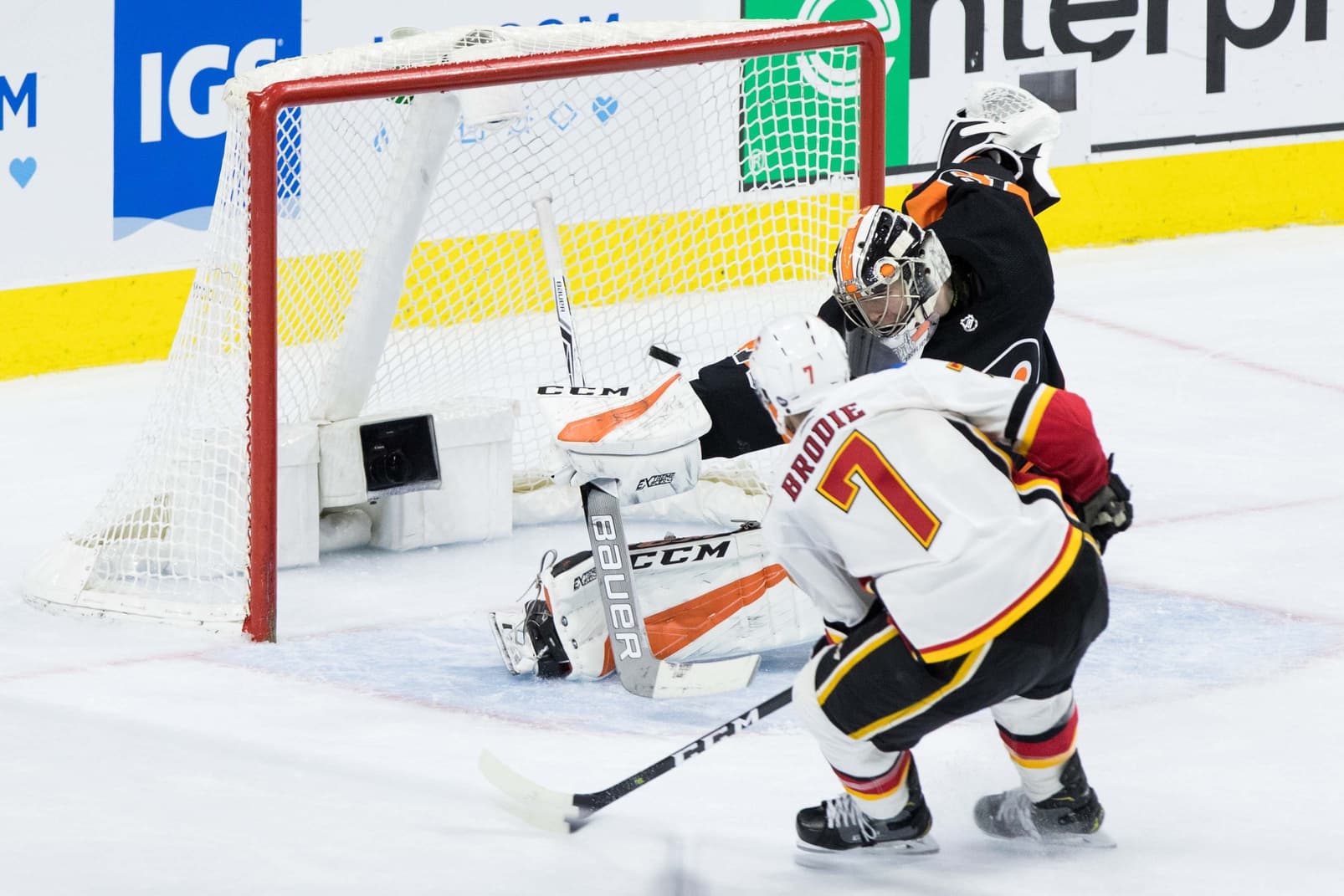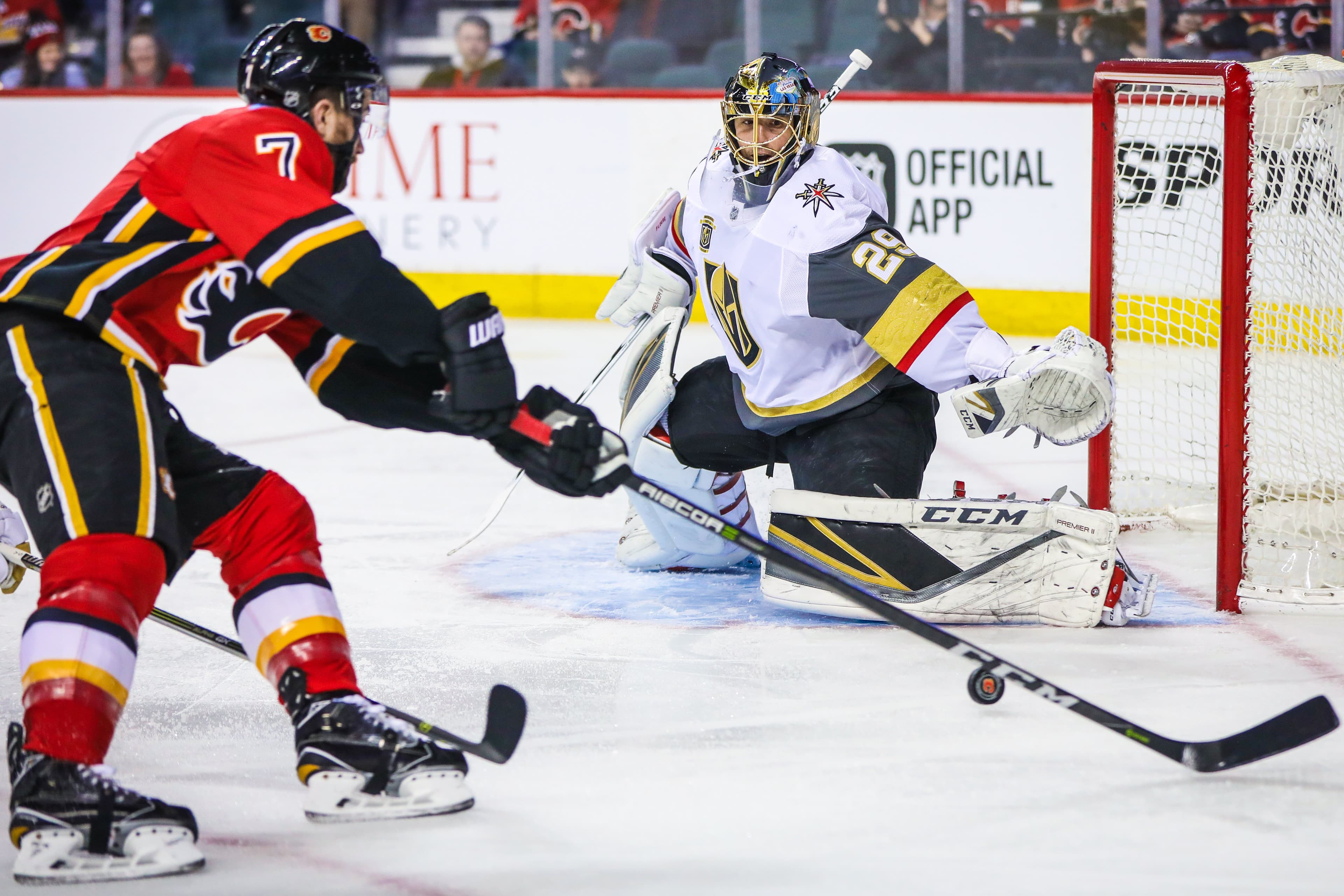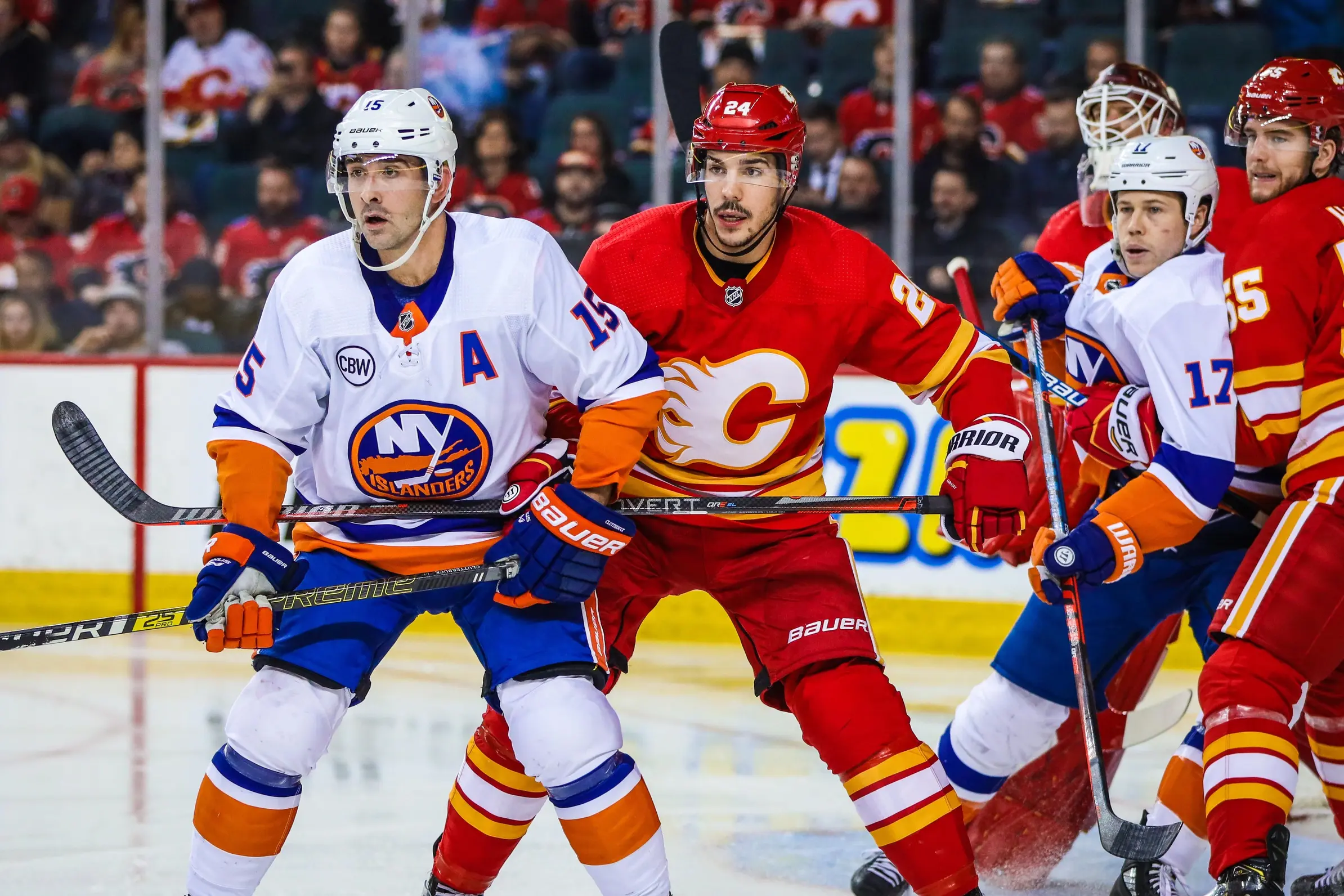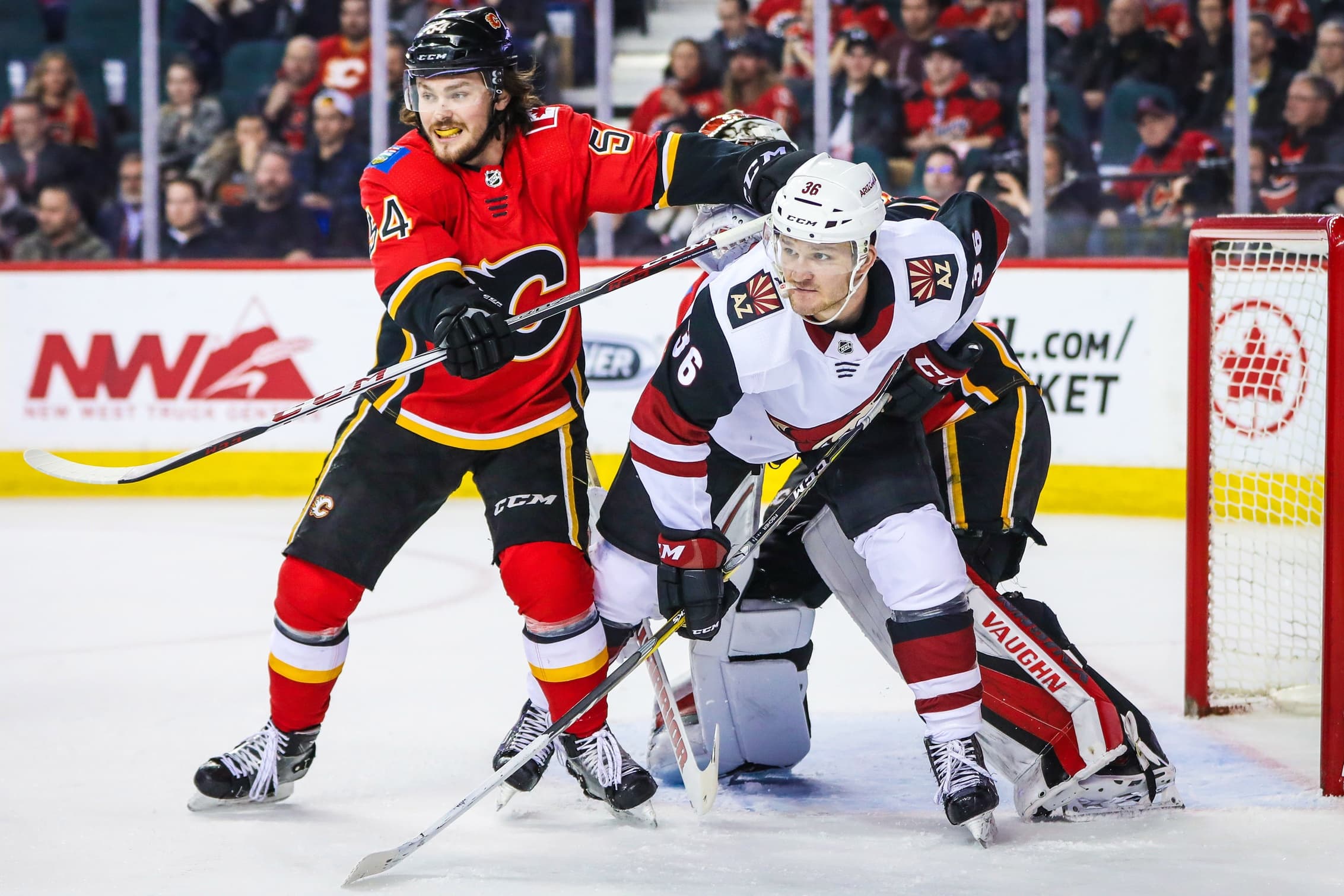Nation Sites
The Nation Network
FlamesNation has no direct affiliation to the Calgary Flames, Calgary Sports and Entertainment, NHL, or NHLPA
Which defenceman to deal at the deadline?

Photo credit: Bill Streicher/USA Today Sports
By Craig Petter
Jan 24, 2020, 10:00 ESTUpdated: Jan 23, 2020, 21:44 EST
The rumblings sound everywhere. It is no secret. The Calgary Flames are shopping for a top six forward that whips pucks from his right hand. If management is already browsing the aisles for potential purchases though, they must also be fiddling with their wallets for someone to swap.
Speculation has been wide as to who could be dealt to guarantee the right return, but among the most glaring possibilities shine the two 29-year old, right-side, pending-UFA defencemen on the roster: T.J. Brodie and Travis Hamonic. Their expiring contracts are doubtlessly weighing on Brad Treliving’s mind, and as legitimate top-four caliber defencemen in the NHL, either could be coveted by teams boasting that right-shot forward.
The two blueliners, however, drastically differ in their style of play. Brodie’s best games bring jolts of mobile flash to his team’s back end, whereas Hamonic can fortify any blueline when he’s playing at his hardy, upright peak. Each role can present advantages to prospective buyers depending on their needs, but could also entice the Flames themselves in preparing for a playoff push and planning pacts to be penned in the off-season. Since many such questions cloud the near future, let’s clarify each players’ respective merits that must be considered before ink dries on any deals.
Brodie’s edges give him one edge

Nobody who sees T.J. Brodie execute a breakout or trail a rush should discount his skating ability. He’s a dynamic, agile, elusive defender who has energized the Flames’ blueline for years; he also shows this talent most when he has the puck. Naturally, his stats therefore eclipse Hamonic’s in production and possession. (Data via Puckpedia.)
GP | G | A | P | GF% | CF% | relCF% | G/60 | P/60 | |
Brodie | 44 | 1 | 13 | 14 | 54.7 | 52.0 | +2.40 | 0.08 | 0.90 |
Hamonic | 44 | 3 | 7 | 10 | 45.5 | 49.6 | -1.80 | 0.15 | 0.62 |
As demonstrated above, Brodie vaunts more points and a considerably higher points-per-game than Hamonic, as well as superior Corsi and Fenwick numbers. Much of his value, therefore, can be localized on his stick, which could sway buyers looking for offensive contributions to set him as their price. For Treliving and the Flames, however, the prevailing question is whether this stick at the blueline is dispensable to add another right-handed one at forward.
Concerning price, however, general managers hoping for a painless trade-and-sign situation will be scrutinizing these players’ current deals as benchmarks for new contracts. Coupled with his higher offensive upside, Brodie’s slightly more lucrative current deal ($4.65 million versus Hamonic’s $3.86 million) implies that locking him down would be costlier compared with signing Hamonic. Brodie also currently wields an 8 team no-trade clause in his contract, which could complicate some simmering deals.
Hamonic’s highlights

Whereas Brodie shines with his stick, it seems that Hamonic makes better use of his body. Although his number of hits is far from monstrous at only 32, Hamonic still crushes Brodie’s mere 14 checks. Plus, Hamonic sacrifices his body in the defensive zone far more often, having blocked 94 shots so far this year to occupy the silver berth among Flames (behind Mark Giordano). Brodie, has blocked 58 and also registers 20 less pounds on the scale than Hamonic, so the latter fulfills the white-knuckled resilient blueliner role a tad better.
The defensive tilt in Hamonic’s favour checks out, however, as more of a home-front soldier at heart. A quintessential shutdown defenceman at his best, Hamonic’s game is more reserved than Brodie’s. Instead of showing up on the scoresheet, he appears more in shooting lanes and opponent’s faces, crucial components of a strong team defense that cannot be devalued.

Hamonic, however, carries another arbitrary but curious element to the Flames that Brodie does not. So far this season, Travis Hamonic has led all Flames in ice time on 7 occasions. The Flames record when he fronts the charge? 7-0-0.
Since Geoff Ward took over the helm, his higher reliance on the second pairing has been clear. 6 of those games have occurred since December, and Hamonic apparently thrives with those extra minutes. Of the 7 games as well, 6 have been tight one-goal contests, so Hamonic has been entrusted with his highest minutes in precarious, pivotal games.
This string of opponents has not been exclusively pushovers either, as Hamonic led wins against both Colorado and Edmonton so far, two teams ahead of the Flames in the standings. It’s a curious stat, but signifies a certain degree of coaches’ confidence in Hamonic’s game that has not gone unredeemed, so this trend could impact how he’s handled at the deadline too.
Ultimately though, how the Flames navigate the next month will be a meditation on their needs. Which style of defenseman could milk the better return? Which player would be more useful in a playoff run? Does the need for a top-six forward even outweigh the comfort of a top-four defenceman? Will someone like Rasmus Andersson fill that top-four role seamlessly anyways?

Both Brodie and Hamonic present urgent matters to be resolved, one of a more offensively effective (but expensive) breed compared to a quieter defender deploying different (but valuable) skills and showing some promising trends.
At this point Treliving has been served copious food for thought regarding these two, but as the deadline creeps nearer, there’s dwindling time to feast. One only hopes his decision makes room for dessert.
Breaking News
- Flames Prospect Roundup: Jacob Battaglia had a four-point night
- NHL Notebook: Sabres fire general manager Kevyn Adams
- Beyond the Boxscore: Flames extinguished by Celebrini magic in 6-3 loss to the Sharks
- 3 predictions for the rest of the Flames season
- Report: The Flames have received plenty of calls about Rasmus Andersson since the Quinn Hughes trade
